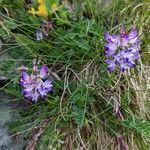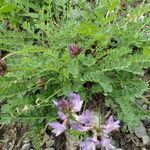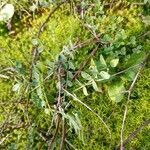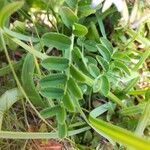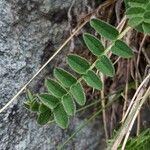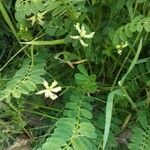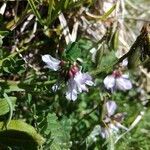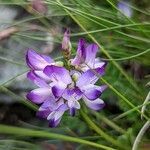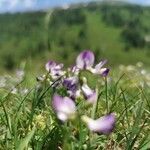Plants caespitose, mostly low, with ± appressed white and black hairs. Stems several to many, slender, prostrate to ascending, 1-15(-20) cm, sparsely hairy. Leaves 2-8 cm; stipules 1.5-6 mm, lower high connate behind stem, upper shortly connate or free, all ciliate; petiole 0.5-4 cm, like rachis slender, sparsely to loosely hairy; leaflets in 7-12 pairs, narrowly elliptic, 5-15(-20) × 2-5(-7) mm, abaxially somewhat densely hairy, adaxially glabrous or sparsely hairy, more rarely rather densely hairy on both surfaces, apex rounded to slightly retuse. Racemes short, densely 5-15-flowered; peduncle 3-8(-15) cm, erect, sparsely to loosely white hairy, toward raceme increasingly black hairy; bracts triangular, 0.5-2 mm, black ciliate. Calyx 4-6 mm, appressed black hairy; teeth 1-3 mm. Petals violet with whitish base, wings often whitish, often yellowish when dry but mostly with violet-tipped keel; standard rhombic-elliptic to widely elliptic, 9-13 × 6-7.5 mm, apex emarginate; wings 7-12 mm; keel 9-12 mm, limbs triangular, 6-8 × 3-3.5 mm. Legumes nodding, with a stipe 2-5 mm, ellipsoid, 7-13 mm, 3-3.5 mm high and wide, attenuate at both ends, keeled ventrally, deeply grooved dorsally, with a short beak, 1-locular or nearly so; valves thin, loosely to rather densely covered with appressed to semispreading black hairs. Seeds 2.5-3 × 2-2.5 mm, smooth.
More
Stems glabrous or nearly so, decumbent, 1–5 dm, scattered on a freely branching, subterranean caudex; stipules connate; lfls mostly 15–25, narrowly oblong to oval, 1–2 cm, sparsely hairy on both sides or glabrous above; racemes long-peduncled, 2–4 cm, loosely few-fld, elongating with maturity; fls nodding, purple or purplish, 10–13 mm; cal-tube broad, 2 mm, the triangular lobes 1 mm; keel slightly to evidently surpassing the wings, equaling or a little shorter than the standard; fr pendulous, lance-oblong, 8–13 mm, ± falcate, pubescent with mixed black and white hairs, evidently trigonous, deeply sulcate on the lower side, the suture also intruded to form a partial partition; stipe 2–4 mm; 2n=16, 32+. Circumboreal, extending s. on gravelly river-banks and lake-shores to Nf., Me., Vt., and Wis., and in the w. to Colo. June–Aug. Typical var. alpinus, with the cal and fr densely pubescent with loosely ascending hairs ca 0.5 mm, occurs in Bayfield Co., Wis., and is widespread far beyond our range. (Atelophragma a.) Var. brunetianus Fernald, with the hairs of the pod shorter (0.2–0.4 mm) and usually appressed, occurs from e. Vt. to Que. and Nf. (A. labradoricus)
